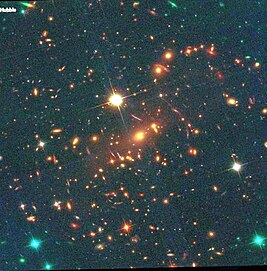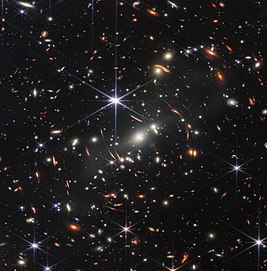SMACS J0723.3–7327
SMACS J0723.3–7327,通常称为SMACS 0723,是在南天星座飞鱼座内,距离地球40亿光年[2]的一个星系团(RA/Dec = 110.8375, −73.4391667)[6][7][8][9]。它是从地球上的南半球可见的一片天空,经常被哈伯太空望远镜和其它望远镜观测到,以寻找遥远的过去[2]。它是詹姆斯·韦伯太空望远镜(JWST)拍摄的第一张全彩影像的目标,使用{{link-en|NIR相机|NIRCam]]成像,包括谱密度,显示了被该星团透镜化的物体,红移意味着它们有131亿年的历史[10]。该星系团先前已由哈伯太空望远镜(HST)以及普朗克[11]和钱卓[12],作为南天大质量星团调查(SMACS)的一部分进行了观测[13]。
| SMACS J0723.3–7327 | |
|---|---|
 来自詹姆斯·韦伯太空望远镜的红外影像,其第一张深场显示了引力透镜下的遥远星系。 | |
| 观测数据(历元J2000) | |
| 星座 | 飞鱼座 |
| 赤经 | 07h 23m 19.5s[1] |
| 赤纬 | -73° 27′ 15.6″[1] |
| 红移 | 0.390[1] |
| 同移距离 | 大约40亿光年[2] |
| 其它名称 | |
| PSZ1 G284.97-23.69[3] PLCKESZ G284.99-23.70[4][5] | |
| 参见:星系群、星系团、星系团列表 | |
在2022年,在SMAC 0723的引力透镜场中,一些当时最古老的大质量星系团在被称为"火花星系"的一个透镜星系中被发现[21],可能包含第三星族星[来源请求]。
参考资料
编辑- ^ 1.0 1.1 1.2 Coe, Dan; Salmon, Brett; Bradač, Maruša. RELICS: Reionization Lensing Cluster Survey. Astrophysical Journal. Oct 2019, 884 (1): 85. Bibcode:2019ApJ...884...85C. S2CID 119041205. arXiv:1903.02002 . doi:10.3847/1538-4357/ab412b.
- ^ 2.0 2.1 2.2 Overbye, Dennis; Chang, Kenneth; Tankersley, Jim. Biden and NASA Share First Webb Space Telescope Image. The New York Times. 2022-07-11 [2022-07-12]. ISSN 0362-4331. (原始内容存档于2022-07-12) (美国英语).
- ^ PSZ1 G284.97-23.69. SIMBAD. 斯特拉斯堡天文资料中心.
- ^ PLCKESZ G284.99-23.70. SIMBAD. 斯特拉斯堡天文资料中心.
- ^ SMACS J0723.3-7327. NASA/IPAC Extragalactic Database. [2023-03-07]. (原始内容存档于2022-07-12).
- ^ WRAL. SMACS J0723.3-7327. WRAL.com. 2022-07-10 [2022-07-12]. (原始内容存档于2022-07-12) (英语).
- ^ Astronomers eagerly await first images from the James Webb Space Telescope. CBS News. July 11, 2022 [2022-07-12]. (原始内容存档于2022-09-26) (美国英语).
- ^ SRELICS. irsa.ipac.caltech.edu. [2022-07-12]. (原始内容存档于2022-07-12).
- ^ RELICS: Reionization Lensing Cluster Survey. archive.stsci.edu. [2022-07-12]. (原始内容存档于2018-01-05) (英语).
- ^ Webb's First Deep Field (NIRSpec MSA Emission Spectra). WebbTelescope.org. [14 July 2022]. (原始内容存档于2023-03-07) (英语).
- ^ PSZ1 G284.97-23.69. simbad.u-strasbg.fr. [2022-07-12]. (原始内容存档于2012-09-26).
- ^ CXC-DS. Chandra Data Archive: Search Results. Chandra X-ray Center/SAO. 2015. doi:10.25574/15296.
- ^ Repp, A.; Ebeling, H. Science from a glimpse: Hubble SNAPshot observations of massive galaxy clusters. Monthly Notices of the Royal Astronomical Society. Sep 2018, 479 (1): 844–864. Bibcode:2018MNRAS.479..844R. doi:10.1093/mnras/sty1489.
- ^ Chow, Denise; Wu, Jiachuan. Photos: How pictures from the Webb telescope compare to Hubble's - NASA's $10 billion telescope peers deeper into space than ever, revealing previously undetectable details in the cosmos.. NBC News. 12 July 2022 [16 July 2022]. (原始内容存档于2022-07-15).
- ^ Garner, Rob. NASA's Webb Delivers Deepest Infrared Image of Universe Yet. NASA. 11 July 2022 [12 July 2022]. (原始内容存档于12 July 2022).
- ^ Overbye, Dennis; Chang, Kenneth; Tankersley, Jim. Biden and NASA Share First Webb Space Telescope Image – From the White House on Monday, humanity got its first glimpse of what the observatory in space has been seeing: a cluster of early galaxies.. The New York Times. 11 July 2022 [12 July 2022]. (原始内容存档于12 July 2022).
- ^ Pacucci, Fabio. How Taking Pictures of 'Nothing' Changed Astronomy - Deep-field images of "empty" regions of the sky from Webb and other space telescopes are revealing more of the universe than we ever thought possible. Scientific American. 15 July 2022 [16 July 2022]. (原始内容存档于2022-07-16).
- ^ Deliso, Meredith; Longo, Meredith; Rothenberg, Nicolas. Hubble vs. James Webb telescope images: See the difference. ABC News. 14 July 2022 [15 July 2022]. (原始内容存档于2022-07-15).
- ^ Kooser, Amanda. Hubble and James Webb Space Telescope Images Compared: See the Difference - The James Webb Space Telescope builds on Hubble's legacy with stunning new views of the cosmos.. CNET. 13 July 2012 [16 July 2022]. (原始内容存档于2022-07-17).
- ^ Atkinson, Nancy. Now, We can Finally Compare Webb to Other Infrared Observatories. Universe Today. 2 May 2022 [12 May 2022]. (原始内容存档于10 May 2022).
- ^ Robert Lea. James Webb Space Telescope spots 'Sparkler Galaxy' that could host universe's 1st stars. SPACE.com. 29 September 2022 [2023-03-07]. (原始内容存档于2023-03-07).
外部链接
编辑- SMACS J0723.3-7327 (页面存档备份,存于互联网档案馆) STScI. Hubble Legacy Archive website
- NASA’s Webb Delivers Deepest Infrared Image of Universe Yet (页面存档备份,存于互联网档案馆) NASA Press release

